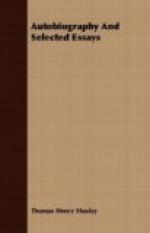But does the formula which expresses the essential structural character of the highest animal cover all the rest, as the statement of its powers and faculties covered that of all others? Very nearly. Beast and fowl, reptile and fish, mollusk, worm, and polype, are all composed of structural units of the same character, namely, masses of protoplasm with a nucleus. There are sundry very low animals, each of which, structurally, is a mere colourless blood-corpuscle, leading an independent life. But, at the very bottom of the animal scale, even this simplicity becomes simplified, and all the phaenomena of life are manifested by a particle of protoplasm without a nucleus. Nor are such organisms insignificant by reason of their want of complexity. It is a fair question whether the protoplasm of those simplest forms of life, which people an immense extent of the bottom of the sea, would not outweigh that of all the higher living beings which inhabit the land put together. And in ancient times, no less than at the present day, such living beings as these have been the greatest of rock builders.
What has been said of the animal world is no less true of plants. Imbedded in the protoplasm at the broad, or attached, end of the nettle hair, there lies a spheroidal nucleus. Careful examination further proves that the whole substance of the nettle is made up of a repetition of such masses of nucleated protoplasm, each contained in a wooden case, which is modified in form, sometimes into a woody fibre, sometimes into a duct or spiral vessel, sometimes into a pollen grain, or an ovule. Traced back to its earliest state, the nettle arises as the man does, in a particle of nucleated protoplasm. And in the lowest plants, as in the lowest animals, a single mass of such protoplasm may constitute the whole plant, or the protoplasm may exist without a nucleus.
Under these circumstances it may well be asked, how is one mass of non-nucleated protoplasm to be distinguished from another? why call one “plant” and the other “animal”?
The only reply is that, so far as form is concerned, plants and animals are not separable, and that, in many cases, it is a mere matter of convention whether we call a given organism an animal or a plant. There is a living body called Aethalium septicum, which appears upon decaying vegetable substances, and, in one of its forms, is common upon the surfaces of tan-pits. In this condition it is, to all intents and purposes, a fungus, and formerly was always regarded as such; but the remarkable investigations of De Bary [99] have shown that, in another condition, the Aethalium is an actively locomotive creature, and takes in solid matters, upon which, apparently, it feeds, thus exhibiting the most characteristic feature of animality. Is this a plant; or is it an animal? Is it both; or is it neither? Some decide in favour of the last supposition, and establish an intermediate kingdom, a sort of biological No Man’s Land [100] for all these questionable forms. But, as it is admittedly impossible to draw any distinct boundary line between this no man’s land and the vegetable world on the one hand, or the animal, on the other, it appears to me that this proceeding merely doubles the difficulty which, before, was single.




